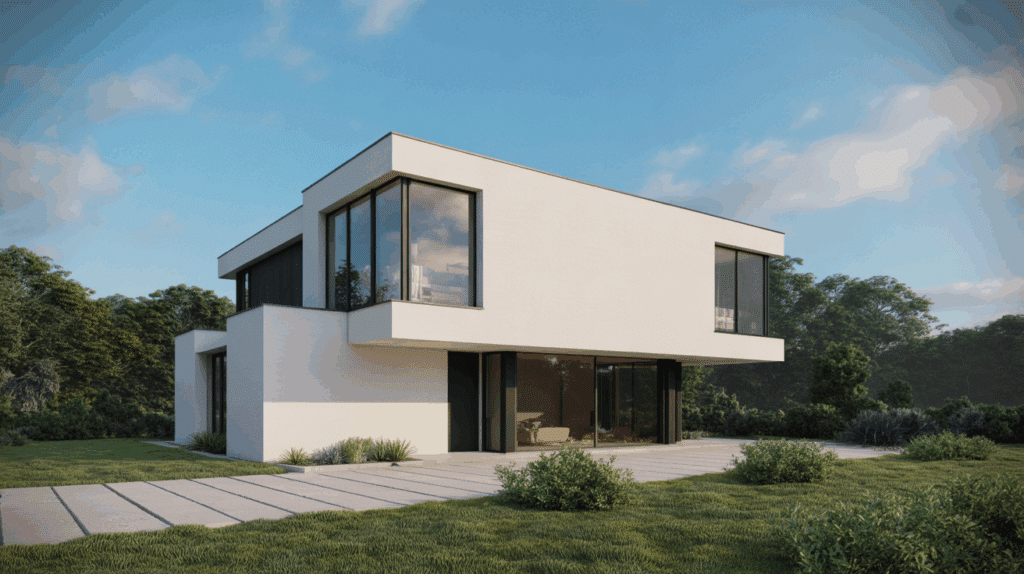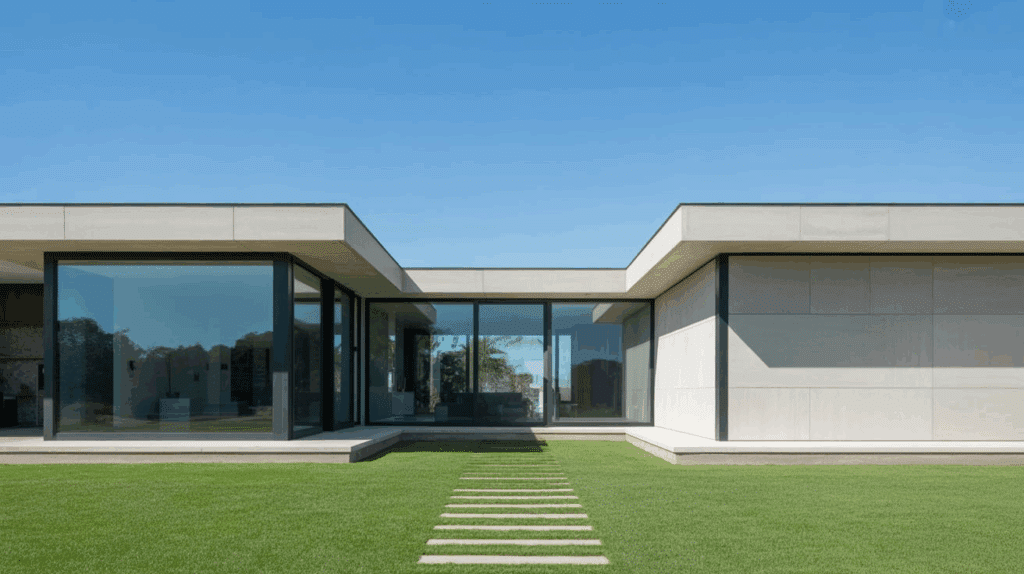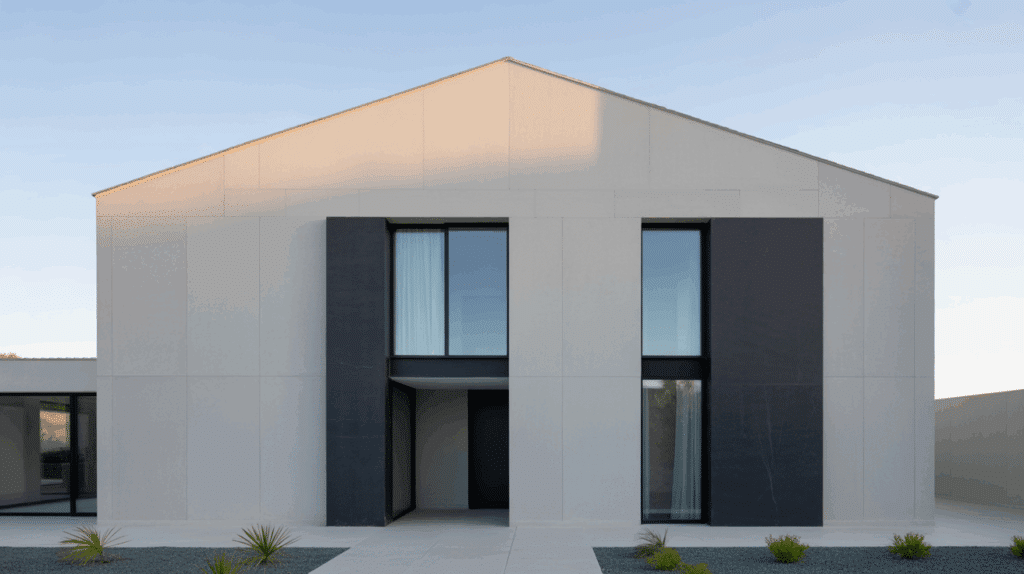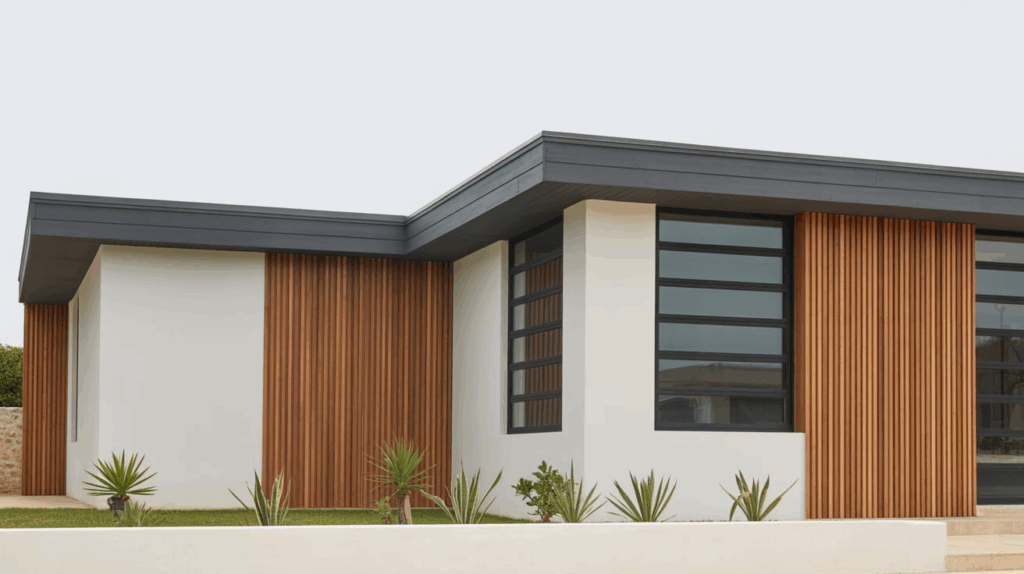I’ve always liked the calm feeling that comes from a home with clean lines and open space. If you’ve felt the same, you’ll love what minimalist house design can do for your home. It keeps things simple while making every detail count.
In this guide, I’ll show you how to design a minimalist exterior that feels peaceful, balanced, and easy to maintain.
You’ll find ideas for roofs, colors, and materials that keep your house looking neat without spending a fortune. Let’s walk through how less really can mean more for your home’s design.
What Makes a Minimalist Exterior
A minimalist exterior uses simple geometry, flat or low-pitched roofs, and limited materials. The goal is to create balance without excess detail.
Instead of using many trims or ornaments, minimalist homes rely on:
- Plain walls and clean roof edges
- Large, simple windows for natural light
- Neutral colors like white, gray, or beige
- Natural textures such as wood, concrete, or stone
This style isn’t cold; it’s calm and clear. You’ll notice how light and shadow play a big role in making the design feel alive.
Minimalist House Exterior Core Principles to Follow
When designing your home’s exterior, stick to a few key ideas:
- Keep the form simple: A box, rectangle, or L-shape works well. Avoid too many rooflines or curves.
- Use a few materials: Limit yourself to two or three. For example, white plaster, light wood, and black metal accents.
- Focus on balance: Make windows, doors, and walls align neatly.
- Highlight natural light: Choose wide windows and glass doors that blend the inside and outside.
- Design the landscape to match: Use clean paths, low plants, and uncluttered surroundings.
Minimalist House Design Ideas
These striking examples show how simplicity and smart design choices can create homes with maximum visual impact and lasting appeal.
1. White Box Home with Black Trim

Create strong visual contrast with pristine white plaster walls paired against sharp black window frames and trim.
The flat roofline emphasizes horizontal simplicity while the monochromatic palette ensures enduring appeal. This classic combination delivers architectural impact through restraint, showing that minimalism offers plenty of visual interest.
2. Concrete and Wood Blend

Marry industrial concrete walls with warm wood slat accents near entryways or feature walls. The raw texture of concrete provides cool polish while natural wood introduces organic warmth and tactile interest.
This pairing balances hard and soft elements, creating welcoming facades that feel both contemporary and inviting.
3. Dark Exterior with Greenery

Bold black or charcoal exteriors create dramatic backdrops for lush landscaping and greenery. The dark palette recedes visually, allowing plants to pop while maintaining modern polish.
This nature-meets-minimalism approach softens architectural severity, showing that contemporary design can work beautifully with natural surroundings and environmental context.
4. Single-Slope Roof House

A shed-style roof with one continuous slope offers practical drainage while adding dynamic geometric interest. This asymmetrical roofline creates architectural movement without complexity or fussy details.
The simple angle provides opportunities for clerestory windows and varying ceiling heights inside, improving both form and interior spatial quality.
5. Glass Corner House

Floor-to-ceiling windows meeting at building corners dissolve boundaries between indoor and outdoor spaces. These transparent junctions frame panoramic views while flooding interiors with natural light.
Corner glazing makes bold architectural statements, creating light-filled living spaces that feel expansive and connected to their surroundings.
Minimalist House Facade and Roofline Ideas
The exterior shell of your minimalist home sets the tone for its entire look, combining clean surfaces with thoughtful material choices.
6. Flat or Low-Slope Roofing

Modern minimalist homes favor flat or gently sloped roofs that create clean horizontal lines. These rooflines eliminate visual clutter and emphasize the home’s geometric form.
They’re practical for integrating rooftop elements like solar panels or green roofs while maintaining that signature contemporary look.
7. Smooth Pitched Roof Design

When selecting a pitched roof, opt for simple, unadorned slopes without decorative trim or exposed rafters. Clean angles and seamless transitions between roof and walls maintain minimalist principles.
Choose monochromatic colors that match your façade rather than contrast, creating a unified architectural statement.
8. Large Uninterrupted Wall Surfaces

Maximize expansive, flat wall planes without unnecessary breaks or ornamental details. These bold surfaces become architectural statements themselves, showcasing material quality and creating dramatic shadow play throughout the day.
The simplicity allows your home’s form and proportions to take center stage rather than competing with decorative elements.
9. Mixed Material Combinations

Combine contrasting materials like crisp white stucco with warm wood slats to add depth without sacrificing minimalism.
Strategic material placement creates visual interest through texture rather than ornamentation. This approach introduces warmth and tactile variety while respecting the clean-lined look that defines modern minimalist architecture.
10. Clean Lines Without Moldings

Eliminate traditional architectural embellishments like crown moldings, archways, and decorative frames. Sharp, precise edges where walls meet roofs and windows create refined simplicity.
This stripped-back approach highlights honest construction and material beauty, letting form and function speak for themselves without unnecessary decoration.
Materials That Fit the Style
Your materials decide how calm or busy your house looks. Choose natural, long-lasting options with simple finishes:
- Wood: Light or medium tones like oak or cedar for accent panels or doors.
- Concrete: Smooth or brushed texture for walls or paths.
- Metal: Matte black or gray for window frames and railings.
- Stone: Large, simple slabs or clean masonry lines.
Stick to matte or low-sheen finishes. Glossy surfaces draw too much attention and break the calm feel.
Windows and Doors
Large windows and simple frames are central to minimalist design. Use slim frames, black or natural aluminum, and keep shapes consistent.
For doors, flush panels with hidden hinges work best. A wood front door can warm up a cool-colored house. Avoid ornate handles or carved panels.
If privacy is a concern, use frosted glass or place windows where they bring light but not direct views inside.
Choosing the Right Colors for a Minimalist House
To help you plan your palette, here’s a quick guide to base colors, accent options, and how each combination affects your home’s overall feel:
| Base Color | Accent Option | Best Pairing |
|---|---|---|
| White | Light wood | Bright and airy feel |
| Gray | Black metal | Modern and balanced |
| Beige | Dark bronze | Warm and soft contrast |
| Off-white | Natural stone | Calm and organic look |
| Black | Cedar or oak | Striking but grounded |
When you choose colors that share a similar tone or texture, your home looks cohesive from top to bottom. This simple harmony keeps the exterior clean, modern, and pleasant to look at year after year.
Landscaping and Outdoor Details
A minimalist home pairs well with clean, open outdoor spaces. The goal is to make the house and yard feel like one design.
Here are simple landscaping ideas that fit:
- Straight or gently curved walkways made of stone or concrete.
- Small trees or bushes spaced evenly, not crowded.
- Gravel beds or grass strips between pavers.
- Low lighting that highlights walls or paths instead of drawing attention to fixtures.
Avoid cluttering the yard with too many planters or ornaments. Let the house shape stand out.
Keeping It Simple on a Budget
You don’t need a large budget to design a clean, modern home. The key is to plan smart, use fewer materials, and let simple shapes do the work.
Focus on what matters most instead of adding layers that raise costs without improving the look.
| Tip | Description |
|---|---|
| Simplify Shapes | Stick to basic rooflines and rectangular forms. Fewer angles reduce material waste and construction time. |
| Limit Wall Finishes | Choose one main wall finish instead of several. A single texture creates a clean look and cuts costs. |
| Use Lighting Wisely | Keep outdoor lights few but well-placed; focus on key spots like the entryway or walkway. |
| Skip Extra Details | Avoid decorative trims, shutters, and layered roofs. They add cost without improving function. |
| Prioritize Quality | Invest in durable materials that age well instead of spending on multiple design features. |
These small choices help you achieve a true minimalist look without overspending. By keeping every design move intentional, you’ll end up with a home that feels refined, balanced, and long-lasting.
Mistakes to Avoid for Minimalist Exteriors
Even simple designs can look messy if you overdo them. Minimalist exteriors need balance, so pay attention to small details and avoid these common mistakes:
- Too many materials or colors: Stick to two or three for a clean, unified look.
- Shiny or patterned finishes: Use matte or natural textures to keep the style calm.
- Decorative trims or columns: Skip extra detailing and let simple shapes stand out.
- Poor maintenance: Keep surfaces clean; dust and stains show faster on plain walls.
- Overcrowded landscaping: Use fewer plants or features so the house stays the focus.
Small, mindful choices make a big difference. When every element serves a purpose, your home feels balanced and easy on the eyes.
Wrap-Up
I hope this gave you a clear sense of how small changes can reshape the way your home feels. With a minimalist house design, every choice matters; from the roofline down to the color of your walls.
It’s not about doing less for the sake of it; it’s about creating a space that feels balanced and easy to live with.
If you’re ready to simplify your exterior or just need new ideas, start with one small update and build from there.
Take your time, trust your eye, and enjoy the calm that comes from clean design. Check out my other posts for more simple ways to refresh your home.














